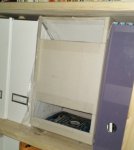- Joined
- Dec 11, 2015
- Messages
- 1,410
As a rough figure and using the formula from the Wikipedia article on the stack effect, it should be possible to get 2 - 4 liters / second airflow through the case via natural convection already at a dT of 20 Kelvin.
dT of 20K is huuuge... Unless the server is placed in a winter-environment & outdoors.
What components in the presumed build would generate a dT of 20K in relation to ambient temperature and still work within recommended temperature range? ....not your laptop hdd's for sure. They'll be on the "sauna side of life".
The only thing going up through that chimney is the life expectancy of those laptop hdd's...
SSD's tho... ;)
The main problem in doing this experiment and trying to transfer conclusions to the case of useless laptop HDD's is that light bulbs are designed to work without additional cooling. Hard drives are not. They tend to get excessively overheated just sitting on a desk while doing intensive io, such as the regular scrubs.I might sound crazy, but I'm drawn to try it using cardboard and light bulbs. Stay tuned ;-)
I must admit I'm a bit too inspired by this discussion for my own best :P
SSD's, planning for all out passive setup, a highly efficient PSU, a chimney setup, a backup fan that ideally would be programmed to only run during intensive io.. It would've been such a sweet build.
You'd probably get away with a pico psu if you choose the right components. Then your powersupply is both cheap and weak, but efficient, small and without moving parts. (I use a pico psu for a i3-6100 + 1x SSD, +1x 120mm fan for router)









